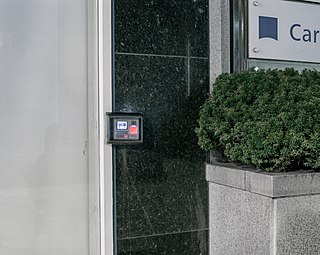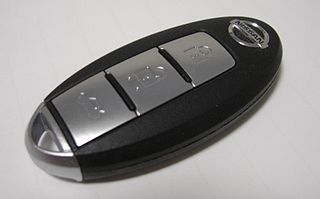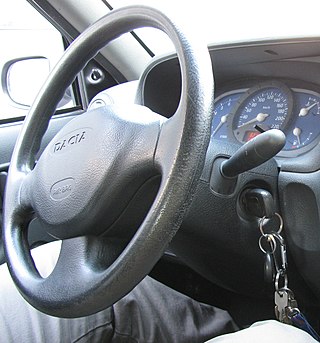
In physical security and information security, access control (AC) is the selective restriction of access to a place or other resource, while access management describes the process. The act of accessing may mean consuming, entering, or using. Permission to access a resource is called authorization.

An alarm device is a mechanism that gives an audible, visual, combination, or other kind of alarm signal to alert someone to a problem or condition that requires urgent attention.

Motor vehicle theft or car theft is the criminal act of stealing or attempting to steal a motor vehicle.
A distress signal, also known as a distress call, is an internationally recognized means for obtaining help. Distress signals are communicated by transmitting radio signals, displaying a visually observable item or illumination, or making a sound audible from a distance.

A car alarm is an electronic device installed in a vehicle in an attempt to discourage theft of the vehicle itself, its contents, or both. Car alarms work by emitting high-volume sound when the conditions necessary for triggering it are met. Such alarms may also cause the vehicle's headlights to flash, may notify the car's owner of the incident via a paging system, and may interrupt one or more electrical circuits necessary for the car to start. Although inexpensive to acquire and install, the effectiveness of such devices in deterring vehicle burglary or theft when their only effect is to emit sound appears to be negligible.

On trains, the expression emergency brake has several meanings:

An alarm clock or alarm is a clock that is designed to alert an individual or group of people at a specified time. The primary function of these clocks is to awaken people from their night's sleep or short naps; they can sometimes be used for other reminders as well. Most alarm clocks make sounds; some make light or vibration. Some have sensors to identify when a person is in a light stage of sleep, in order to avoid waking someone who is deeply asleep, which causes tiredness, even if the person has had adequate sleep. To turn off the sound or light, a button or handle on the clock is pressed; most clocks automatically turn off the alarm if left unattended long enough. A classic analog alarm clock has an extra hand or inset dial that is used to show the time at which the alarm will ring. Alarm clock functions are also used in mobile phones, watches, and computers.

A smart key is an electronic access and authorization system that is available either as standard equipment or an option in several car designs. It was developed by Siemens in 1995 and introduced by Mercedes-Benz under the name "Keyless-Go" in 1998 on the W220 S-Class, after the design patent was filed by Daimler-Benz on May 17, 1997.

A fire alarm control panel (FACP), fire alarm control unit (FACU), fire indicator panel (FIP), or simply fire alarm panel is the controlling component of a fire alarm system. The panel receives information from devices designed to detect and report fires, monitors their operational integrity, and provides for automatic control of equipment, and transmission of information necessary to prepare the facility for fire based on a predetermined sequence. The panel may also supply electrical energy to operate any associated initiating device, notification appliance, control, transmitter, or relay. There are four basic types of panels: coded panels, conventional panels, addressable panels, and multiplex systems.

Power door locks allow the driver or front passenger to simultaneously lock or unlock all the doors of an automobile or truck, by pressing a button or flipping a switch.

A car key or an automobile key is a key used to open and/or start an automobile. Modern key designs are usually symmetrical, and some use grooves on both sides, rather than a cut edge, to actuate the lock. It has multiple uses for the automobile with which it was sold. A car key can open the doors, as well as start the ignition, open the glove compartment and also open the trunk (boot) of the car. Some cars come with an additional key known as a valet key that starts the ignition and opens the driver's side door, but prevents the valet from gaining access to valuables that are located in the trunk or the glove box. Some valet keys, particularly those to high-performance vehicles, go so far as to restrict the engine's power output to prevent joyriding. Recently, features such as coded immobilizers have been implemented in newer vehicles. More sophisticated systems make ignition dependent on electronic devices, rather than the mechanical keyswitch. A number of these systems, such as KeeLoq and Megamos Crypto have been demonstrated to be weak and vulnerable to cryptanalytic attacks.

A remote keyless system (RKS), also known as remote keyless entry (RKE) or remote central locking, is an electronic lock that controls access to a building or vehicle by using an electronic remote control. RKS largely and quickly superseded keyless entry, a budding technology that restrictively bound locking and unlocking functions to vehicle-mounted keypads.

A panic alarm is an electronic device that can easily be activated to request help during an emergency where danger to persons or property exists. It is designed to contact assistance quicker, easier, and simpler than a conventional phone call.

A tell-tale, sometimes called an idiot light or warning light, is an indicator of malfunction or operation of a system, indicated by a binary (on/off) illuminated light, symbol or text legend.

A check engine light or malfunction indicator lamp (MIL), is a tell-tale that a computerized engine-management system used to indicate a malfunction or problem with the vehicle ranging from minor to serious. Found on the instrument panel of most automobiles, it usually bears the legend engine, check engine, service engine soon, maintenance required, emiss maint, or a pictogram of an engine—and when illuminated, it is typically an amber or red color.

An immobiliser or immobilizer is an electronic security device fitted to a motor vehicle that prevents the engine from being started unless the correct key is present. This prevents the vehicle from being "hot wired" after entry has been achieved and thus reduces motor vehicle theft. Research shows that the uniform application of immobilisers reduced the rate of car theft by 40%.
An annunciator panel, also known in some aircraft as the Centralized Warning Panel (CWP) or Caution Advisory Panel (CAP), is a group of lights used as a central indicator of status of equipment or systems in an aircraft, industrial process, building or other installation. Usually, the annunciator panel includes a main warning lamp or audible signal to draw the attention of operating personnel to the annunciator panel for abnormal events or condition.
Driver drowsiness detection is a car safety technology which helps prevent accidents caused by the driver getting drowsy. Various studies have suggested that around 20% of all road accidents are fatigue-related, up to 50% on certain roads.
A vehicle tracking system combines the use of automatic vehicle location in individual vehicles with software that collects these fleet data for a comprehensive picture of vehicle locations. Modern vehicle tracking systems commonly use GPS or GLONASS technology for locating the vehicle, but other types of automatic vehicle location technology can also be used. Vehicle information can be viewed on electronic maps via the Internet or specialized software. Urban public transit authorities are an increasingly common user of vehicle tracking systems, particularly in large cities.

A smart lock is an electromechanical lock that is designed to perform locking and unlocking operations on a door when it receives a prompt via an electronic keypad, biometric sensor, access card, Bluetooth, or Wi-FI from a registered mobile device. These locks are called smart locks because they use advanced technology and Internet communication to enable easier access for users and enhanced security from intruders. The main components of the smart lock include the physical lock, the key, a secure Bluetooth or Wi-Fi connection, and a management mobile app. Smart locks may also monitor access and send alerts in response to the different events it monitors, as well as other critical events related to the status of the device. Smart locks can be considered part of a smart home.















